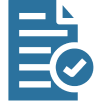Level 1b – Diagnosis & Analysis

Summary
A practitioner at Level 1b will have knowledge of Lean diagnostic, analytical and planning techniques and the ability to use them in the workplace to understand customer/stakeholder value, the current state, solve problems and propose future states.
Prerequisites for Level 1b

Level 1a.
Note that this refers to the knowledge of L1a, rather than specifically the qualification. A course that encompasses several levels may not issue a L1a certificate, though it will cover L1a knowledge as part of the learning journey.
Accredited organisations can choose to have separate courses for L1a, L1b and L1c and certify at each level or have a programme that incorporates more than one level and only certify at the highest level covered, as suits their specific needs.

Level focus
On the diagnostic and analytical tools used to understand processes, customer value and to solve problems.
Level knowledge outcomes
- B1: Purpose, customer/stakeholder value identification and understanding
- B2: Mapping techniques
- B3: Quality approaches
- B4: Problem solving techniques
- B5: Basic data gathering/statistical techniques
- B6: Planning and communication techniques
- B7: Demand and capacity analysis and understanding techniques

Level practice outcomes
LCS 1b practice focuses on the ability to:
- Analyse a process/value stream through the application of mapping and other diagnostic techniques
- Use problem solving techniques to identify and define problems and issues and improve processes and quality
- Understand how to improve and plan for improvements as a result of diagnostic activities
- Undertake activities and use techniques to understand customer value and the ‘voice of the customer’
- Recognise and map different types of value streams in organisations to create the ‘current state’
- Map processes in organisations
- Understand variation
- Solve problems
- Develop ‘future state’ maps
- Undertake basic data gathering and statistical techniques to help diagnose and solve problems
- Understand customer/stakeholder value and analyse customer demand data.

Indicative Topics
A training programme that aims to cover the knowledge requirements for LCS Level 1b is likely to reference several of the following topics.
Purpose, customer/stakeholder value
QFD; Kano; VoC; cycle of service; service encounter; idea management; public value (Moore)
Mapping
Current state and future state; value stream mapping, Learning to See, brown paper mapping; SIPOC; process mapping, spaghetti diagrams; quality filter; customer journey; swim lane; four fields; flow charts.
Quality
Kano model; seven quality tools (cause-and-effect diagram/fishbone, check sheet, control chart, histogram, Pareto chart, scatter diagram, flow chart/run chart); mistake proofing, Gaps model of service quality; poka yoke; checklists; variation reduction & six sigma, SPC; etc
Problem-solving
FMEA; means-ends analysis; soft systems methodology; 8D problem solving; DMAIC; PDCA; A3; Five Whys; CATWOE; Four Frame approach; Drill Down; Cause & Effect (Fishbone) etc
Data and analysis:
Seven quality tools; Design of Experiments; Measurement Systems Analysis /Gage R&R; surveys; Kingman’s equation
Demand and capacity
Demand analysis and understanding; value/failure demand identification; ToC five steps
Planning & communicating
QCD measures; A3; visual management; communication boards; project management and organisation; team roles and function; Agile approach – scrum
The topics should be contextualised for the organisation for which the training is intended and those selected will depend on several factors – such as the nature of the organisation’s processes, whether it is manufacturing products or delivering intangible services – internally or externally, whether it is private or public sector, etc. This list is indicative; some topics may not be relevant, some will require passing reference only and there may be other topics that are not included.

Delivery
A course or programme designed to deliver Level 1b outcomes can be organised in several ways and there is no prescribed format. It will typically use a combination of:
- Face to face, taught in groups – in modules or blocks of days
- Digital delivery and elearning
- Workplace based guidance and support – going to the ‘Gemba’.
The total learning time guidance for a course or programme is 40 hours. This can include face to face teaching, elearning, assessment, pre/post course reading/research, practical application, offline group work, on the job training and one-to-one support activities.
Learning hours shown are meant to be indicative and a guide, rather than prescriptive; they are not a target and ideally a consequence of delivering effective training that addresses stated learning outcomes.
Note that a course could encompass two levels – for example, L1b and L1c. In these cases the learning hours are not additive, as synergies and economies of scale come into play.

Level Assessment
The assessment shall demonstrate that the outcomes have been achieved.
Knowledge
An assessment that demonstrates the learner can remember and understand Level 1b Diagnosis & Analysis, for example, through a multiple choice test, problem or case-based exams, oral exam, essay exam.

Practical Application
The successful Level 1b practitioner shall provide evidence of the application of Level 1b related tools and techniques in the workplace. Methods that should be used to capture the evidence include A3 reports, project reports, workbook, project portfolio/log or diaries.
Talk to our qualified experts today about starting your LCS journey



